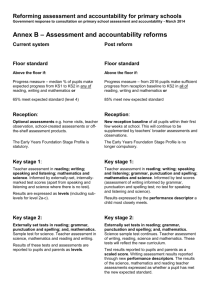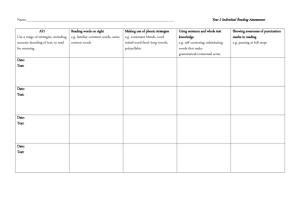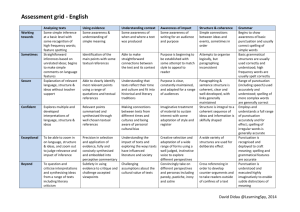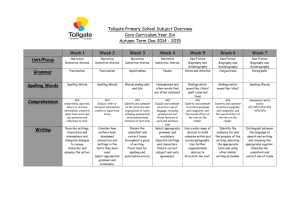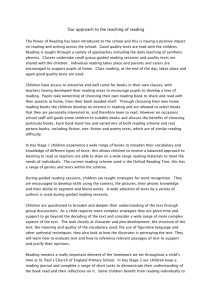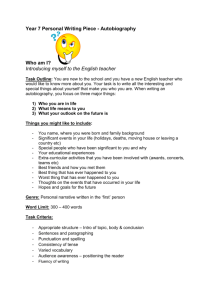Key Stage 2 SAT Parent Information Evening
advertisement
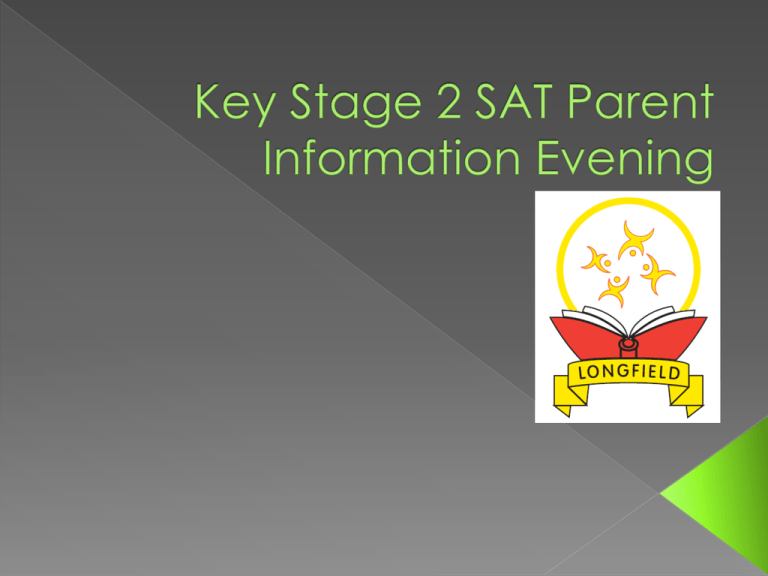
Statutory Assessment Tests Usually taken at the end of Key Stage 1 (at age 7) and at the end of Key Stage 2 (at age 11). Children are expected to achieve Level 4 by the end of Key Stage 2. Some children will still be at Level 3 and some children will achieve Level 5 or 6. A small percentage of children will not yet be working at Level 3. It is the schools decision whether a pupil will be entered for any of the tests. For children working at Level 3 and above, there are two sorts of assessments: tests and teacher assessments. For children working below Level 3, the only statutory assessment is teacher assessment and those children do not take the tests. For pupils to be awarded a Level 6 they need to sit the level 3-5 papers, gain a high level 5 and sit the level 6 papers and gain a level 6. This year it is the week beginning 13th May. All tests take place in that week. Children may not take them earlier or later. A timetable is issued to schools to tell them when tests should be completed, this is the same nationally. Usually there is one test per day (with the exception of those pupils sitting the level 6 papers) and it is a busy week for children and staff alike. Tests are completed in classrooms, with any displays that may help covered over. The Reading Assessment English Grammar, of Literacy punctuation and is covered Spelling by two tests: 15 minutes independent reading time and 45 minutes to read and answer questions. Covers the Assessment Focuses of: Accurate decoding of text; understand, describe and select information from texts; deduce, infer or interpret information from texts; identify and comment on structure of texts; explain and comment on writers use of language; identify and comment on writers’ purposes, viewpoints and the overall effect on the reader; relate texts to their social, cultural and historical contexts. Short answers: 1 mark; Longer answers up to 3 marks; some answers may involve completing a diagram or drawing arrows. This test will be sent off to be externally marked. A new test this year which will focus on four areas: Spelling, punctuation, sentence-grammar and vocabulary. Handwriting may be included but schools have not had this confirmed. This test will be sent off to be externally marked. The Assessment of Numeracy is covered by three tests: Mental Mathematics Mathematics test A Mathematics test B There are 20 questions which the children hear on tape. Each question is read twice. They involve a range of skills. Working out time is 5, 10 or 15 seconds. In this 45 minute written paper, calculators are not allowed. Some questions are worth one mark and therefore accuracy is important. Other questions are worth two marks and even if the answer is wrong, a mark may be given for correct working. This paper is similar to Paper A but there are larger numbers and a calculator is allowed (and needed). Teacher assessment draws together everything the teacher or teachers know about a child, including observations, marked work and school assessments. Tests are a snapshot’ of a child’s abilities on that day. There can be a difference between teacher assessment results and test levels. Help is only for pupils who have an identified issue e.g. learning need, or physical impairment. Some children can be given up to 25% extra time if they have identified learning needs. This has to be applied for by the school in advance. Even if applied for the STA can refuse the application. Words written on a test paper by the child can be transcribed where a marker may not be able to read a child’s answer. If your child is working at level 3 then they will require more support from home in the regular use of English and Mathematic skills. Don’t try and frighten them into revising – encourage them and tell them they can do well. Support them with homework. Make sure they get enough sleep. Make sure they eat breakfast. It is important they arrive at school on time. Please help them not to panic!


